Archive for Uncategorized
March 15, 2007 at 9:33 pm · Filed under Uncategorized
The scourge of Puerto Peñasco is condominium development. The north shore, called “Sandy Beach” is being completely covered by high-rise buildings, each offering a more “luxurious” living experience than the next. You can see the billboards along Rt 8 as you drive into town. These developments are primarily for Americans, and each one has a Sales Office, a gang of real estate agents, and a model home NOW OPEN, just like US condo developments.

Condos going up along Sandy Beach. Click for extra large view.
The pace of real estate development in Mexico is quite a bit slower than in the US, and apparently hazardous. All over town there are remnants of projects begun but not finished. Skeletons of steel framework, foundations poured over sand, lots cleared of their original modest structures but now accumulating only garbage, tattered and faded signs promising exciting new homes “coming soon” “¦ all of these things suggest a boom-or-bust mentality, and to the skeptical real estate investor they spell Buyer Beware. It would be very dangerous to take advantage of “Pre-construction pricing”, given that the construction phase might never be completed. A few people that Ken & Petey have talked to are caught in exactly that bind. Their condominium is three years behind schedule. Mañana “¦
Still, at least half a dozen major projects are underway on Sandy Beach, and several are already open. Nearby is Playa Bonita RV park, one of the nicest in town, similar to Playa de Oro but facing a nicer stretch of beach and some frankly beautiful views.
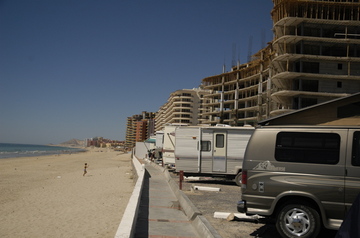
Front row at Playa Bonita RV Park
I’d stay in the park, but I can’t see buying one of the condo properties. As these developments go up, they emphasize the boundary between the “haves” and the “have nots”. The road to the resorts may be gated, paved, and lined with palm trees just like in Florida, but just a block to either side the streets are still made of sand, lined with roofless shacks, trash, mongrel dogs, and other indicators of a poor people. It’s a startling disparity of wealth that is sealing off miles of their beach for the exclusive use of Norteamericanos.
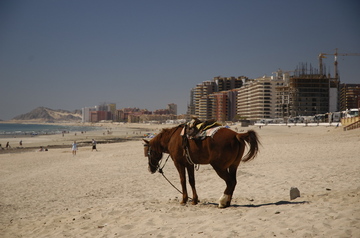
Rent a horse at Sandy Beach
Google Earth location of Sandy Beach.
To the south of town, along Los Conchos Beach, development has taken the form of miles of single-family residences clustered along a narrow strip of coastline. Driving through this area is almost surreal because of the strange architectural styles. Most of the houses have a “Mediterranean” influence, but odd visual cues are everywhere. One house brags both Roman columns and Russian minarets. Others are a hodge-podge of Greek, Spanish, and Turkish styles.
The entire neighborhood is accessible only by hard-packed sand streets, and since most of the houses are rentals or “fractionals” (a form of timeshare ownership), the neighborhood is transient and sterile. But for a pure getaway, just to hang with the family and play on the beach, it looks good. The view to the calm blue water of the Sea of Cortez is admittedly beautiful.
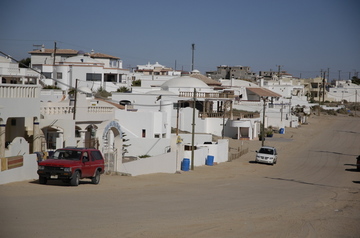
Google Earth location of Los Conchos Beach area.
Do we feel safe? Yes, we do. There’s much more to be concerned about, crime-wise, in New Orleans, Miami, or even tiny Ajo, Arizona. This is not a border town, and the drug problems that go with borders seem to have bypassed Puerto Peñasco. The beach is lightly populated with families playing games on the sand, and college students admiring each other from beach towels. The RV park is full of happy Americans walking around in towels, and not one sign of a criminal element has appeared. We are much more comfortable here than we would be camping in many US downtowns.
The worst problem seems to be badly inebriated college students. Puerto Peñasco apparently wants to reach the Ft. Walton/Destin standard of Spring Break, and the town is getting there. Billboards and signs on the restaurant/BARs advertise to their prurient interests (binge drinking and wet t-shirt contests), and so from late afternoon onward it’s not hard to find evidence of the unfortunate results. Yesterday Ken was favored with a view of a student vomiting next to a trailer here in the park, while the student’s friends offered unhelpful comments ( “Hey, you gonna be OK, man?”). One hopes that it was his own trailer he was tossing cookies on, and not one belonging to some poor visitor from Colorado.
There is a feeling of “anything goes” here, but it’s really not true. They do rent ATVs to college students and let them roar through town on them, helmetless and belching, but the police are still visible where needed. At night the scene is probably horrific with crowds on the streets and various mating displays rivaling Mardi Gras in the French Quarter, but at that time we are back in the Airstream enjoying dinner while the cool sea breeze blows through our open windows.
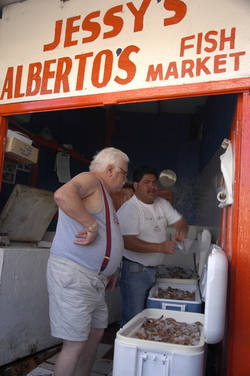
Selling shrimp in the Old Port
The Old Port is the only part of the town that is reminiscent of a border town like Tijuana, Ciudad Juarez, or Nogales. There you’ll find the usual border town shops carrying pharmaceuticals, tacky t-shirts, pottery, and other trinkets. But even still, it is nicer than the border towns. The open-air pescaderia has beautiful shrimp, clams, and fish, and friendly but not aggressive hawkers selling them. We would have bought a bunch of seafood, but this morning I bought a pound of jumbo shrimp for $7 from a vendor who was driving through our RV park, like the fresh-water vendor.
So we’ll grill the shrimp tonight and then go buy something else fresh tomorrow. In fact, since US Customs doesn’t seem to be concerned about Mexican seafood, we may load up on shrimp to bring back to Tucson, on our last day here.
Google Earth location of Old Port and photos above.
March 13, 2007 at 8:56 pm · Filed under Uncategorized
Organ Pipe Cactus National Monument has changed lately and not for the better, I’m sorry to say. Continuing border problems and the threat of violence from drug-runners has caused the park service to shut down all back-country hiking trails and all the border roads in the park. This effectively eliminates the majority of access to the park’s many subtle delights. Old mines, historic ranch sites, even the tiny habitat of the endangered Quitobaquito desert pupfish ““ all are off limits now. Now it seems that visitors to the park have joined the desert pupfish as an “endangered” species needing protection.
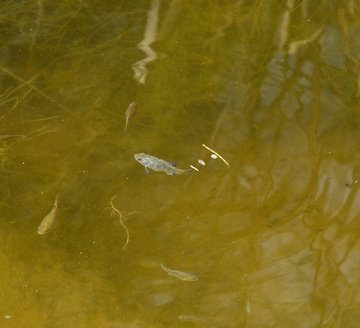
The endangered Desert Pupfish. Note the male fish is blue.
A year ago the border was a problem too, but only a small portion of the park was closed at that time. The most recent closures have changed the essence of the experience at Organ Pipe. It is still a peaceful and beautiful place, but the tension of border problems is an ever-present cloud. The rangers have to spend too much of their time explaining why you shouldn’t explore parts of the park ““ something that must really frustrate them. The Visitor Center is named for a ranger who was shot to death by criminals who crossed the border.
A short distance from the campground you can find large blue flags on a tall pole, indicating one of several humanitarian water stations. These are put in the park to aid the everyday “UDAs” (Undocumented Aliens) who attempt to hike 80 or more miles through brutal desert conditions with completely inadequate preparation. Many of them have no idea what conditions they will face, when they cross the fence. Once they’ve realized their mistake, rather than dying in the desert they can get water and wait for help (which will include deportation).
Fear is now a factor in the park. The park visitors, the rangers, the border control agents, and the UDAs all feel it. Hiking in the park in years past we would have looked for rattlesnakes, gila monsters, cactus wrens, or kangaroo rats. Now, will you see any of those or will you be too busy looking for an armed drug runner, a desperate family without enough water, or a giant pile of trash left by border crossers long since departed?
I don’t mean to pick on Organ Pipe Cactus National Monument. It’s still a wonderful park and it doesn’t deserve the problems it faces. We’ll come again and enjoy it again. But the huge changes we’ve seen here in just one year reminds me that all parks are subject to change as a result of environmental, political, climatological, or even geographical changes.
When you visit one, try to experience as fully as your time allows. Next time you visit, things may have changed, especially in border parks. During our first visit to Big Bend National Park, we were able to freely cross the Rio Grande to have dinner in Boquillas Mexico. Now that’s illegal. In Hawaii Volcanoes National Park, lava flows can ebb to barely anything, so if the lava is visible, it’s worth staying until dusk to see it!
One year I planned to visit Cabrillo National Monument during a business trip to San Diego, but my free day was September 12, 2001, and the monument ““ being close to a naval base ““ was off-limits for a few panicky days. It was four years before I got another chance at it.
In Sabino Canyon (part of the Catalina National Forest in Tucson), floods during the last monsoon season wiped out trails that we could have hiked the previous year, if we’d taken the time. We’ve accumulated dozens of other examples, too. The point is that even in national parks, where the goal is preservation for future generations, nothing is static. Seize the day!
The good news is that Organ Pipe is not heavily visited, so seekers of peace and quiet can still find it here. The RV campground in Organ Pipe Cactus National Monument has no hookups. The park also takes no reservations, cell phone coverage is marginal, and the park is far from population centers and services. These factors keep visitation to the campground down.
Last year we had to leave the park earlier than we wanted because the furnace chewed up our power at night and even running the generator for the maximum four hours allotted each day wasn’t enough to keep up. This year we have solar panels, like most of the other residents here. Solar is ideal for places like Organ Pipe because it silently recharges the batteries all day, not just during the posted generator hours, and there’s plenty of sunshine here. We have had more than enough power to fully recharge the batteries every day.
Next to us are Richard and Norma, who coincidentally I met last year at the International Rally in Salem OR. Richard is a woodcarver, and his trailer has several delicate hummingbird carvings hanging from it. He carved one just for Emma, too, from a single piece of wood. It’s a beautiful thing, and just the right size and weight to be a good full-timer’s souvenir. We’ll find a place in the Airstream to hang it.
Two spaces down are Bert & Janie, and today Ken & Petey showed up in their 1964 Airstream Globe Trotter, so that makes four Airstreams in our immediate area.
Our Google Earth campsite location in Organ Pipe.
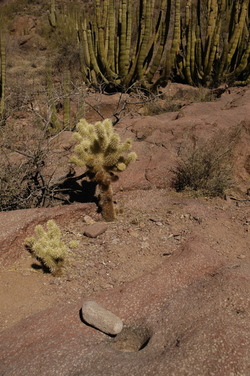
A grinding hole, cholla cactus, and organ pipe cactus
Today Bert recruited me for a hike by Alamo Canyon. Janie came along, but Eleanor stayed back because Emma was still sleeping. The hike started about 10 miles north of the campground (and three miles down a bumpy dirt road), following a perennial stream to an old one-room ranchhouse and corral. Along the dry streambed there are ancient Native American grinding holes in the bedrock, fifteen by our count. These are quite possibly thousands of years old, and were used to grind up mesquite seeds and other gatherings. We’ve encountered these in Big Bend National Park and other places, but they always are awe-inspiring and make me think about how the people before us managed to live here.
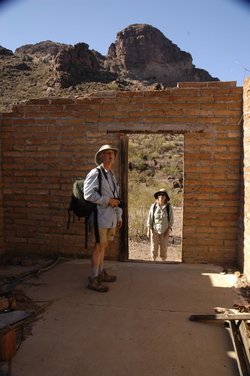
Bert & Janie explore an abandoned one-room ranch house, Alamo Canyon
This evening Bert went back out to Alamo Canyon to shoot a particular night scene. He wanted to capture saguaro cactus against the Ajo Mountains with the stars creating circular trails overhead. This picture requires a tripod, very clear skies, a view of the Polaris (the north star), a cable release, and a camera that has a “Bulb” setting that holds the shutter open indefinitely. He came back successful, with a gorgeous 15-minute exposure that appears on his blog. I wish I’d tried it too, but we hung back to attend the 7 p.m. ranger talk about Organ Pipe’s sister park in Mexico, called Pincate.
Tomorrow we will disperse. Ken & Petey will follow us across the border to Puerto Peñasco, and Bert & Janie will begin the long trek back to their home in Montana. They’ve been on the road for nine months, ever since we saw them at their home last July. It’s time for a break for them. I hope they’ll be on the road again this fall so we can have more hiking and bicycling trips together.
March 11, 2007 at 8:33 am · Filed under Uncategorized
Finally, the Summer magazine is ready for layout, which means I can relax and enjoy the park! Anza-Borrego is a beautiful place, and this is a great time of year, so it is tragic to waste it sitting in the trailer worrying about work. I’ve tied up the remaining loose ends that I can, and placed all other projects on hold for a week. Whatever problems remain to be solved will just have to wait for a while. I’m on vacation.
I was very happy for Bill & Larry since their first boondocking experience was very successful. They seemed to have no trouble grasping the techniques of water and electricity conservation, and had no fear of being “out in the boonies”, away from a campground. In fact, Larry mentioned to me that when they bought their new Airstream, this was the sort of place they had envisioned camping — with few people around, quiet and peaceful.
They packed up and headed home mid-day, but we and Rich C had already headed off for a bit of exploring in the southern end of the park. About 20 miles away, and three miles down a bumpy, narrow, dirt road, we found the trail to the Marshall South homestead. This family tried to live off the land on the top of a hill in a very remote and difficult area, back in the 1930s.
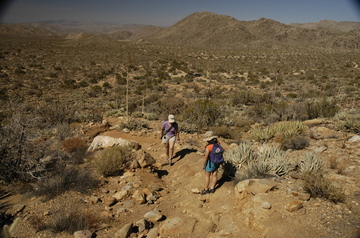
Hiking up the trail to the house
Even today the spot is inhospitable. There is no water — the family used a water-collection system and cistern. All supplies had to be transported via Ford Model T, then carried up a steep rocky trail for a mile. Temperatures in the summer routinely exceed 100 degrees. They lived in a homemade adobe house with no amenities at all, for 16 years, until the wife quit and the family broke up.
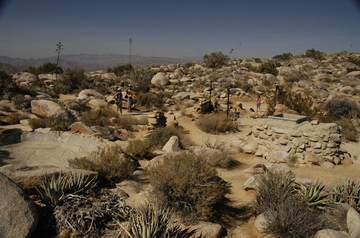
The dissolving remains of the South homestead
We did another short hike as well — the Narrows Earth Trail — since it wasn’t particularly hot. (Temps ran 78-88 depending on altitude.) But if you do some hiking in the desert, keep in mind that even on a moderate day you’ll require a lot of water.
By late afternoon we felt like taking it easy, so we headed to downtown Borrego Springs for a Mexican dinner. It was a perfect time for eating outdoors. In Borrego Springs, the tall mountains to the west block the late afternoon sun, so the town gets a welcome shade around 5 pm (this time of year), and it immediately feels comfortable. The downtown has a certain funky feel, with a few old-fashioned neon signs and small-town businesses, and a big centerpiece called “Christmas Circle” where the town provides a big green lawn and palm trees.
This will be the last daily blog entry for a few days. We are heading to Organ Pipe Cactus National Monument today, in southwestern Arizona, to meet Bert & Janie, and Ken & Petey. Organ Pipe is a wonderfully remote desert park where there is neither cell phone service nor Internet access. We will be completely cut off from the instantaneous communication that has influenced our travels for the past year.
Organ Pipe has no hookups either, which means you need solar or a generator if you want to stay for long. We had to leave the park early last year for lack of adequate power, but now we have two solar panels and four batteries. We’ve already been unplugged for two days and two nights, but with the constant desert sun we are in no danger of running out of power.
We’ll spend two more nights in Organ Pipe, hiking and taking pictures with our friends, and then head into Mexico for four nights. In Mexico we might have some limited Internet access, but I am going to be taking a break from the blog & from business, so most likely I will not update this blog until we return to the USA on March 17 or 18. Check back once in a while, or make a note to come back on March 17 to see how we fared in Mexico. We should have lots of stories and photos to share with you.
March 9, 2007 at 11:01 pm · Filed under Uncategorized
We moved out of the Palm Canyon campground today to do some desert boondocking. Here in Anza-Borrego, there are places where you can camp indefinitely at no charge. One such place located just outside the Borrego Springs city limits is known as “Pegleg”. We hitched up today at noon and headed over to become desert rats.
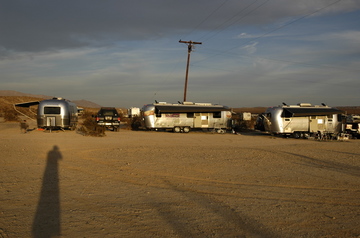
Rich C, and Larry & Bill also came over, so we have our three Airstreams parked together for another night. This is a funky spot. Pegleg is named for Pegleg Smith, a teller of tall tales and a prospector, who supposedly found a gold mine around here decades ago. Of course, nobody knows where it is, but everyone would like to find it. If you want to find it, just add 10 rocks to the pile here at Pegleg.
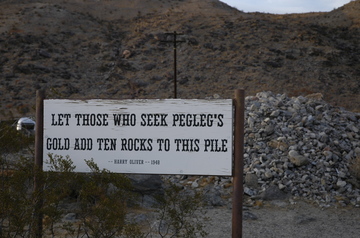
Rudy, a fellow Airstreamer parked nearby, is like many others who come back here year after year. We first met Rudy in January 2006 and he told me about this spot. Ever since, I’ve wanted to come back to check it out … and wouldn’t you know, Rudy’s parked right up the slope. He came over tonight to tell us about his trips to Baja.
It was hot again today, with temperatures in the upper 80s and strong sun. Of course boondocking means no air conditioning, but with the natural breeze, the awning, and our three Fantastic Vents it was very comfortable. In this part of the desert the temperature quickly moderates as the sun sets, and by 5:30 it was perfect for Emma and I to take an exploratory bike ride around the area.
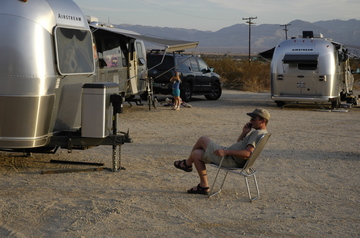
By 7 pm, right after dinner outside Bill & Larry’s trailer, a strong wind came up which encouraged all of us to take the awnings down. It is my rule of thumb that the awning should come down at night, since whenever I neglect to do so there is inevitably a high wind at 2 a.m. Too many times I have been outside in my pajamas taking down the awning in the middle of the night!
Once again this evening the bright stars filled the sky and if possible they were even brighter than before. Out here we are clear of even the small amount of light generated by Borrego Springs, although over the mountains a dim glow can be seen from San Diego. We all stood out there admiring the incredible view. I think we’re all happy to be out here, feeling independent and in a real camping mood, eating outside, seeing the stars, and enjoying the quiet.
Google Earth location of Pegleg.
March 8, 2007 at 10:44 pm · Filed under Uncategorized
I needed to spend the day in the trailer working, which required considerable discipline since it has been an absolutely beautiful day outside. Best I could do was open all the windows and let the warm desert breezes fly through the trailer. Eleanor and Emma at least got out a bit, heading into town to do laundry and talk to some of the locals.
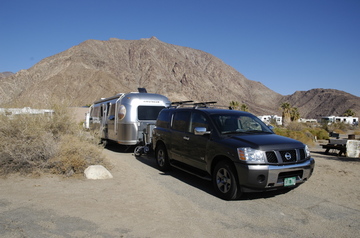
While working, I got the following email note:
Hey there, Rich, Greetings from the Komfort 5th wheel across from you! We’ve been using your WiFi since last night, so thought I’d better pipe up and say thanks. My husband Geno and I RV about 7 months out of the year. He’s cycling up Montezuma Pass right now. Instead of working, I’ve been enjoying your site, the IIM site, the Digital RV forum, etc. If it’s OK, we’ll plan to stop by to meet you this afternoon. Thanks again, Pat
It’s strange to meet people as a result of providing free wi-fi, but hey, whatever works. Pat and Geno popped over after lunch and turned out to be very nice folks. Wish I’d had more time to chat but work still needed to be done, and even now (at 10 pm) there’s more to be done.
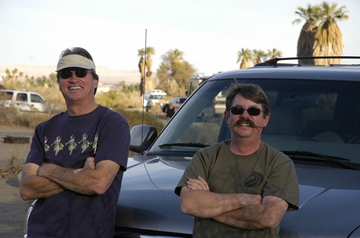
This afternoon we got another visit, from Mike and Sam. We last saw them in Salem, OR at the International Rally. Their wives were unavailable today so the guys drove nearly 2 hours over the mountains from San Diego just to hang out for a couple of hours with us. And they brought us a Dutch Apple pie from Julian Pie Company, which pretty much puts them on our “A List”.
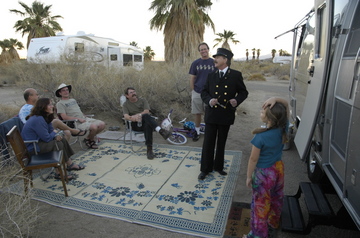
At 5 pm, Bill put on his lighthouse-keeper’s uniform. He does docent work at Cabrillo National Monument, recreating the persona of Capt. Robert Decatur Israel, who managed the Old Point Loma Lighthouse from 1871 to 1891. Since he also looks a lot like the conductor from “The Polar Express”, he did a little routine for Emma based on that story. Between him and Emma it was hilarious. At the end, he presented Emma with a copy of the book and a little silver bell. If you’ve read the book or seen the movie, you’ll know what the bell symbolizes.
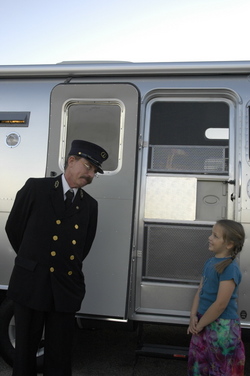
March 7, 2007 at 11:10 pm · Filed under Uncategorized
Our month at the park in Tucson is up, and rather than extend we’ve decided to head west to California for a few days. We’ll go back to Tucson later, after I finish the magazine and take a littlIt e vacation time.
Buying a month at a time in a campground is a new experience to us. Generally when you do that, the campground charges extra for electricity. We used about 384 kwH in the past month, which came out to $45 for the month. I was a bit surprised it was even that much, since we were gone for about 12 days. Still, it was less than our deposit, so I got $5 back upon departure.
It was a long pull along I-8 to Borrego Springs, CA, 386 miles in total. Much of I-8 has little to recommend it, but there are bits of scenic beauty to be found, especially as the route heads into California. Our route took us into the heart of the Imperial Valley, where incredible amounts of vegetables are grown in the desert courtesy of massive irrigation projects and canals. Brawley is a small city in the center of this farming valley, which looks like a decent place but seemed to have a constant smell of cow manure.
Around 5 pm we pulled into Borrego Springs, a town surrounded by the very large Anza-Borrego Desert State Park. This is one of our favorite places. You can see our blog entries from last January for more information about the park; just scroll down to the Archives in the left column and click “January 2006”.
Rich C is here, as well as our friends Bill and Larry in their new 23-foot Safari, and a few other folks in Airstreams. We had a quick bike ride through the park, and then a very mellow get-settled dinner courtesy of Larry this evening, and wrapped up by sitting outside watching the stars. The air is very clear here, and the stars are bright. Emma spotted Orion’s Belt instantly, and then the Big Dipper, and I showed her the Milky Way — something the folks in Palm Springs or San Diego probably never see due to light pollution in those cities. Anza-Borrego is a special place for us and it’s great to be back.
March 6, 2007 at 8:37 pm · Filed under Uncategorized
Work was going so well this morning until Bert showed up around 11 and said, “Let’s go for a hike!” It was a beautiful day, heading into the 80s, and my resolve was weak. So Emma and Zoe the stuffed cat and I threw on our boots and joined Bert & Janie on the Douglas Spring Trail of Saguaro National Park.
(For background, you should know that Zoe the cat comes with Emma on every major hike. She rides in Emma’s backpack with her head sticking out. Zoe has seen more national parks than some national park rangers. She’s a very lucky orange stuffed animal.)
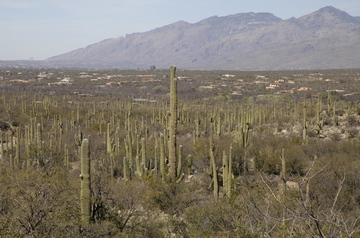
Saguaro forest and the Santa Catalina mountains
Douglas Spring Trail to our destination is 5.2 miles roundtrip, with 1100 feet of elevation gain, “strenuous and rocky,” according to the official park guide. At the trailhead someone warned us that people had spotted “snakes on the trail” this morning, to which we all grinned and thought, “Bonus!” We’ve been hoping to spot a rattlesnake from a safe distance, but thought it was too early in the season to have much of a chance.
So I reminded Emma of what to do if a snake appears or is heard (more likely), and we headed up the rocky trail. No snakes, but plenty of saguaro forest, early desert flowers, and heat. Our greatest challenge was making sure we were all well covered with sunscreen. It was a long slow slog up the slope and I was glad I’d brought a pair of water bottles for each of us.
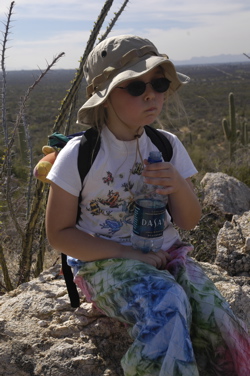
Ultimately it reached 85 degrees in blazing sun, but of course with the extreme aridity the sweat would dry on our bodies in seconds. We found a shady spot by a tiny bit of water with cool rocks and made that our turnaround point for the hike. Sitting on the rocks was enough to make me extremely comfortable, but Emma went the extra mile and dipped her shirt and hat in the water, wrung them out, and put them back on. Her cotton shirt was dry before we got back to the truck.
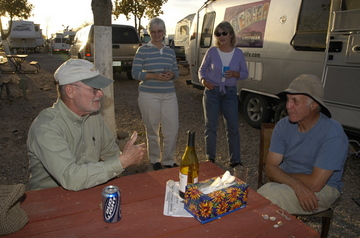
Charlie, Lynn, Janie and Bert outside our trailer
While were gone we found that Mike & Tracy had come by, but we missed them. (Eleanor was out grocery shopping.) But not long after we arrived back at camp, our friends Dr. C and Lynn showed up, and so we gathered up Bert & Janie and went out for dinner.
I was particularly happy about this fortuitous meeting because Dr. C and Bert have both been contributors to Airstream Life since the very beginning of the magazine, and I had not until now had the chance to introduce them to each other. We’re all leaving Tucson this week, so this was our only chance to hang out together. Dr. C and Lynn are heading back to their home in the frozen north on Friday, and Bert & Janie are heading down to Organ Pipe Cactus National Monument where we will see them on Monday.
To see Bert’s recent blog entries about our hikes in Saguaro, see www.gildartphoto.com/weblog
« Previous entries ·
Next entries »





















